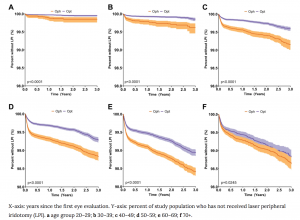In this large retrospective study published in the journal Eye, Dr. Cecilia Lee and her co-authors reviewed data from a Massachusetts claims database to assess how certain risk factors for glaucoma are detected and diagnosed during an eye exam. The authors compared outcomes from both ophthalmologists and optometrists to determine if there were any differences in how often they referred at-risk patients for further evaluation and treatment.
Primary angle closure glaucoma is one of the leading causes of blindness worldwide, affecting ~26% of the glaucoma population globally. Timely detection of occludable narrow angles (condition that can sometimes progress to primary angle closure glaucoma) in patients who are at risk is a key method of prevention. If indicated, patients can be referred for laser peripheral iridotomy to prevent more serious outcomes.

The authors analyzed data from over a million new patient visits in the state of MA during the years 2011-2015. The results showed that that narrow angles are associated with older age and female sex. They also showed that ophthalmologists have a higher detection rate for narrow angles when compared to optometrists.
These findings are significant and suggest that evaluation by ophthalmologists may benefit patients who are at higher risk of PACG, such as older patients and patients with complex ocular conditions that may affect the examination, thus potentially decreasing the risk of complications related to undetected narrow angles.
Lee CS, Lee ML, Yanagihara RT, Lee AY. Predictors of narrow angle detection rate-a longitudinal study of Massachusetts residents over 1.7 million person years. Eye. 2020 June 3. doi: 10.1038/s41433-020-1003-0. Online ahead of print. PMID: 32494044

